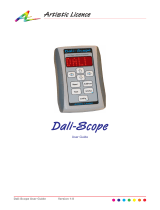Page is loading ...

Artistic Licence
Rail-DALI-DMX Quick Start Guide
Rail-DALI-DMX
Quick Start Guide
Version 1-5
The full User Guide can be downloaded via the following link:

Rail-DALI-DMX Quick Start Guide
Summary
DALI Essentials
Rail-DALI-DMX converts DALI into DMX512.
It is designed for environments that require
integration between the two protocols.
There are 2 main modes of operation: Ballast
mode and Trigger mode.
1. Ballast mode (DIP Switch 6 OFF) enables
control of DMX xtures by a DALI controller.
It does this by simulating virtual ballasts,
each of which has control over a single
DMX channel.
2. Trigger Mode (DIP Switch 6 ON) is used
to trigger a DMX controller.
Page 2
Conventions
In this document, for clarity, we number DALI
ballasts 1-64, and Groups and Scenes 1-16.
On the wire, these actually appear as 0 -63 and
0-15 respectively. Most DALI commissioning
tools use the latter numbering system.
y Max 64 ballasts per bus (= one circuit)
y DALI BUS PSU required to provide voltage
on line (in addition to regular PSU)
y Ballasts used for the rst time must be
commissioned (using e.g. Dali-Scope)
y DALI oers 4 types of control over ballast
intensity: individual channel, group, scene
and broadcast
Ballast Mode
In Ballast Mode, the virtual ballasts act in
the same manner as normal DALI ballasts
and respond to a sub-set of the standard
DALI commands (see User Guide Appendix:
DALI Commands - Overview). All intensity
control commands are supported (individual
channel, group, scene and broadcast).
Rail-DALI-DMX oers the user the option to
simulate 1, 4, 16 or 64 ballasts. The choice
is made via setting DIP switches 3 and 4 as
shown in Table 1. The DMX channels that are
not being used are set to zero.
If the total number of virtual ballasts is
changed, the commissioning procedure must
be carried out again.
DIP Switch
3
DIP Switch
4
Total no. of
Virtual Ballasts
O O 1
O On 4
On O 16
On On 64
Table 1
The product assigns each virtual ballast
a number that denes the output slot for
the DMX data as shown in Table 2. These
numbers are pre-programmed; however, the
system does allow editable short addresses
via commissioning.
Commissioning
As with any DALI product, the Rail-DALI-
DMX must be commissioned to give each
virtual ballast a unique short address.
The choice of short address depends on what
ballasts are already present on the network. If
no short addresses are taken up already, the
default course would be to assign sequential
short addresses starting at 1.
If the Rail-DALI-DMX is not commissioned,
it can still control the DMX xtures when
receiving DALI broadcast commands. This
can be useful during the installation phase
prior to commissioning to check that the
system is responding.
Virtual Ballast No. DMX Data Slot
1 1
2 2
3 3
4 4
5 5
63 63
64 64
Table 2
Dimming Curve
The majority of DMX devices operate using a
linear dimming curve with the level selected
by a decimal value between 0 and 255.
DALI works with a non-linear (exponential)

Page 3
Rail-DALI-DMX Quick Start Guide
Fade Times
0
DMX
DALI
0
255
100%
Ballast Power
Control Value
Rail-DALI-DMX oers the user the ability to
adjust the response curve of the DMX output
in order to mimic that of DALI ballasts.
The choice is set using DIP switch 5. OFF
means no curve correction, while ON will
apply the exponential curve correction.
The correction aects all control modes
(Broadcast, Channel, Group & Scene). The
correction is an approximation; due to the
nature of the conversion the top end is steppy.
Trigger Mode
Trigger Mode is used to trigger a DMX
controller. It enables integration between
existing DALI installations and DMX systems.
Trigger Mode also uses virtual ballasts but, in
contrast to Ballast Mode, they are not proxies
for actual xtures. As such, the DALI control
commands Channel, Group and Scene lose
their literal meaning. Instead, they should be
viewed simply as data streams that enable
various triggering options.
curve. Each method produces a dierent
output, as shown by the graph below.
In Ballast Mode, Rail-DALI-DMX oers three
fade times of 0 (instant), 1 or 4 seconds.
Other input values of fade times are treated
as 0 (instant). Simulated fades only happen
when ‘Direct Arc Power’ commands and ‘Go
To Scene’ commands are used.
Fade times are selected on a ‘per virtual
ballast’ basis using a tool such as Dali-
Scope. Fade times allow the virtual ballast to
perform a simulated fade when they receive
a commanded to adopt a new level. A one-
second fade executes using a fade ramp of
approximately 30 steps, while a four-second
fade uses a fade ramp of approximately
120 steps (note that this feature applies to
products with serial numbers above 0129).
The virtual ballasts are pre-commissioned
to dene this triggering structure. Appendix
Tables 3-6 in the User Guide detail the pre-
programmed relationship between the virtual
ballasts and the DMX output slots.
The number of virtual ballasts can be set as
shown in Table 1.
The Dimming Curve Translation (DIP Switch
5) is operative for Channels and Groups.
Again, it should be remembered that, in
trigger mode, there is no concept of this
describing actual xture intensity levels.
Connections
Dip
Switch
Function
1 Not Used
2 Not Used
3 No. of virtual ballasts (see Tab.1)
4 No. of virtual ballasts (see Tab.1)
5 Dimming Curve (OFF: No correction
ON: Exponential correction)
6 Operation Mode
(OFF: Ballast / ON: Trigger)
No. Type Function
1 LED DALI Received
2 LED Power
3 Connection DMX Output
4 DIP Switch See below
5 Power Input GND Connection
6 Power Input 9 - 24 VDC
7 Connection DALI Connection

Due to our policy of continuing product improvement specications are subject to change without notice
Artistic Licence
The Mould Making Workshop
Soby Mews
Bovey Tracey
TQ13 9JG
United Kingdom
Telephone +44 (0) 20 8863 4515
Fax +44 (0) 20 8426 0551
Email: Sales@ArtisticLicence.com
Web: www.ArtisticLicence.com
Customer support and knowledge base:
www.ArtisticLicence.com/support.html
CE Compliance
Rail-DALI-DMX is CE compliant when installed
in a shielded and earthed metal case
No power light 1. Check that the DC power wires are connected to the correct
terminals and correct polarity.
2. Check power is switched on.
3. Disconnect all non-power cables. Switch o product and leave
for 20 minutes (this allows the thermal fuse to reset). Switch on.
If power light illuminates, it is likely that an external fault or wiring
error is causing the problem.
DALI controller is not
‘seeing’ Rail-DALI-DMX
1. Product not powered on.
2. No DALI bus PSU present.
DMX xtures can only
be controlled by DALI
broadcast commands
1. The Rail-DALI-DMX has not been commissioned. Use a DALI
tool such as DALI-Scope to achieve this.
The data light on
Rail-DALI-DMX is not
illuminated
1. Product not powered on.
2. No DALI bus PSU present.
3. DALI controller not connected.
Scene and Group
commands not working
1. Scene and Group commands are handled dierently in Trigger
Mode. Try switching to Ballast mode (set DIP switch 6 OFF).
2. Scenes and Groups have not yet been programmed.
DMX xtures behaving
erratically
1. DMX cable not terminated at last xture.
2. DMX cable is not suitable (must be data cable).
3. More than 32 DMX xtures on the cable.
When I cycle power
to my DALI ballast,
it powers up at an
unexpected intensity
1. All DALI ballasts have a setting called ‘Power On Level’ which
denes their intensity after power cycle. The ballast will stay at
that intensity until Rail-DALI-DMX next refreshes it. Dali-Scope
can be used to both read and programme the Power On Level.
When I cycle power
to my DALI bus power
supply, the ballasts
go to unexpected
intensities
1. All DALI ballasts have a setting called ‘System Failure Level’
which denes their intensity after a fault such as loss of DALI
bus power supply. The ballast will stay at that intensity until Rail-
DALI-DMX next refreshes it. Dali-Scope can be used to read the
ballast’s System Failure Level. If power is not reinstated after 1s,
all the relevant DMX outputs will ash at full intensity.
Troubleshooting
/



